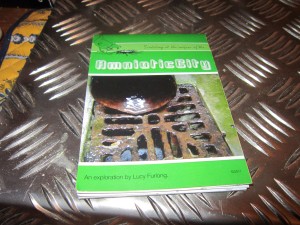Over at eight cuts today, I interview Lucy Furlong about her extraordinary book, Amniotic City. It is a perfect example of self-publishing excellence so I thought I'd have a look at the object itself here.
Amniotic City is a map of the part of East London that cradles the Thames, produced by the wonderful Lucy Furlong. Only it's not just a map, it's a psychogeographic poetic tribute to a side of this wonderful city too rarely see. Looking at the city's architecture and liminal spaces, the poems and the walks through which they lead you as your guide, transforming your view of the city around you, uncover and explore the eternal feminine as she manifests herself all around.
This is a niche book for sure, but to me that's both a fascinating and very strong concept. I've done shows about Lilith and uncovering the ancient feminine, hidden but never eliminated by thousands of years of patriarchal design, is always invaluable. This book brings that process to life in situ, leading you through a hidden London, making you open your eyes and not only that, when you go anywhere, you will look at the "MAN-made" landscape around you through different eyes, and it will be as though the scales have fallen from them.
So, tick one - a book that is specialist and knows exactly what it's doing and has something great to offer readers. This is a niche book for sure, but to me that's both a fascinating and very strong concept. I've done shows about Lilith and uncovering the ancient feminine, hidden but never eliminated by thousands of years of patriarchal design, is always invaluable. This book brings that process to life in situ, leading you through a hidden London, making you open your eyes and not only that, when you go anywhere, you will look at the "MAN-made" landscape around you through different eyes, and it will be as though the scales have fallen from them.
The execution is also brilliant. Presented like a fold up map (not just a gimmick - this means you can - and will - put it in your pocket and use it as such), this opens out into just that - a map. On one side a map leads us around London, with photos taken on Lucy's own travels that both guide us ground us and help us to see the city through her eyes, intimate how we might look differently (such as the coins in the crack in the wall, clearly photographed as fecund or prostituted [is the money going in or coming out? the photograph makes us ask and consider the ambiguity] genitalia).
Lucy uses the device of coloured pins and string to lead us to the reverse on which she has printed the poems, the coloured pins indictaing which is associated with which location. Some of the poems appear suggestively on the page - a tree, swarming bees. All of them make us question the place to which they refer, like an archaeologist's brush delicately uncovering the feminine around us.
In other words, every aspect of the purpose and production of this book have been thought through and work well together. Which is exactly what self-publishing should do.



No comments:
Post a Comment